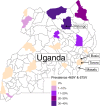Decreased susceptibility of Plasmodium falciparum to both dihydroartemisinin and lumefantrine in northern Uganda
- PMID: 36289202
- PMCID: PMC9605985
- DOI: 10.1038/s41467-022-33873-x
Decreased susceptibility of Plasmodium falciparum to both dihydroartemisinin and lumefantrine in northern Uganda
Abstract
Artemisinin partial resistance may facilitate selection of Plasmodium falciparum resistant to combination therapy partner drugs. We evaluated 99 P. falciparum isolates collected in 2021 from northern Uganda, where resistance-associated PfK13 C469Y and A675V mutations have emerged, and eastern Uganda, where these mutations are uncommon. With the ex vivo ring survival assay, isolates with the 469Y mutation (median survival 7.3% for mutant, 2.5% mixed, and 1.4% wild type) and/or mutations in Pfcoronin or falcipain-2a, had significantly greater survival; all isolates with survival >5% had mutations in at least one of these proteins. With ex vivo growth inhibition assays, susceptibility to lumefantrine (median IC50 14.6 vs. 6.9 nM, p < 0.0001) and dihydroartemisinin (2.3 vs. 1.5 nM, p = 0.003) was decreased in northern vs. eastern Uganda; 14/49 northern vs. 0/38 eastern isolates had lumefantrine IC50 > 20 nM (p = 0.0002). Targeted sequencing of 819 isolates from 2015-21 identified multiple polymorphisms associated with altered drug susceptibility, notably PfK13 469Y with decreased susceptibility to lumefantrine (p = 6 × 10-8) and PfCRT mutations with chloroquine resistance (p = 1 × 10-20). Our results raise concern regarding activity of artemether-lumefantrine, the first-line antimalarial in Uganda.
© 2022. The Author(s).
Conflict of interest statement
The authors declare no competing interests.
Figures






